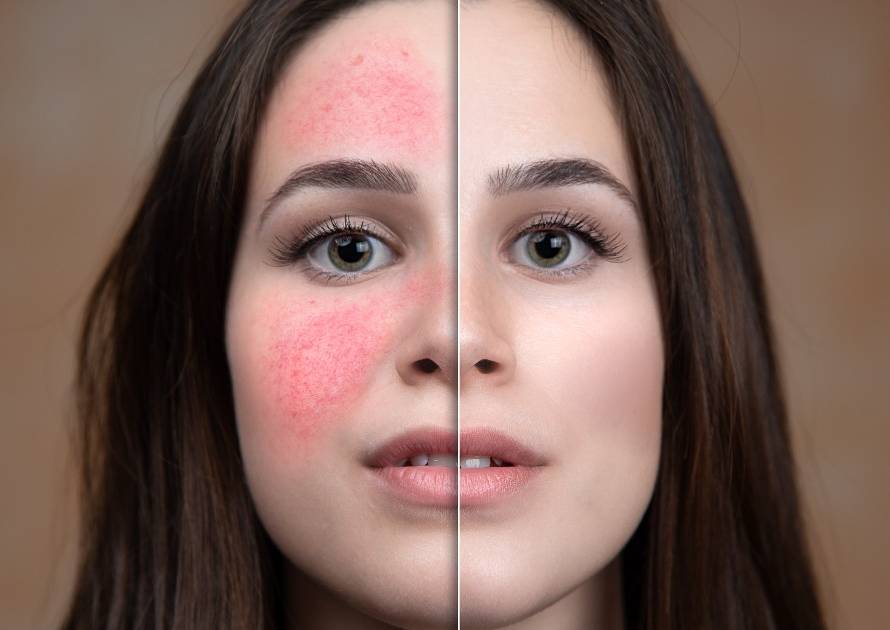Vitiligo is a skin condition in which pale white, smooth patches appear on different parts of the body. It usually starts at the hands, forearms, face, and feet. Around 1% of the world’s population has vitiligo.
This article aims to help you better understand vitiligo, its types, symptoms, causes, treatment, and answers all the most frequently and commonly asked questions regarding the chronic skin condition vitiligo.
Overview
Vitiligo is an autoimmune, chronic, long-term skin condition that causes pale white patches to develop on the skin. The patches usually get bigger with time. This skin condition occurs when the body attacks the melanocytes (cells that produce melanin), or pigment cells which causes a lack of pigment cells in the body and hence, the pale white patches that develop on the skin.
Usually, if the patient gets patches of vitiligo in a place where they have hair, the hair in the patch might also turn white.
What Are the Types of Vitiligo?
This skin disease has so many patterns in which it appears on the body of the patient. Some of these patterns include segmental, acral, Vulgaris, or generalized.
- Segmental: This type of vitiligo affects only one part of the body.
- Acral: This type affects the palms of your hands and the soles of your feet.
- Vulgaris: This type of vitiligo is a combination of acral vitiligo in addition to patches on the areas of the body under which there are joints.
- Generalized: This type of vitiligo affects the entire body.
How Is Vitiligo Diagnosed?
Vitiligo is a skin disease that usually develops in the form of hypopigmented or depigmented lesions that occur spontaneously or after a history of trauma in the area. The pale white patches are usually asymptomatic, which means no redness or itching accompanies them.
Vitiligo patients are diagnosed using wood’s lamplight, which is a device that has a wavelength of 365 mm. When the doctor is diagnosing vitiligo, they examine the skin of the patient under wood’s light. The skin usually appears chalky white.
In rare cases, when the diagnosis cannot be determined, the doctor can take a sample of skin from the patient and perform a skin biopsy.
Since it is an autoimmune disease, the doctor usually does screening for the patient to make sure that they don’t have other autoimmune disorders that are associated with vitiligo, such as alopecia areata, celiac, and pernicious anemia.
How Is Vitiligo Treated?
Each patient with vitiligo would need a customized set of treatments. The doctor takes many factors into consideration, including gender, site affected, body surface area affected, family history, and previous treatments that the patient underwent.
Available treatments of vitiligo include:
- Topical creams: Mainly steroids and calcineurin inhibitors (which have the same efficiency as steroids with minimal side effects). The topical creams used usually have hydroquinone with a 20% concentration.
- Phototherapy: This method is usually used for patients who develop generalized vitiligo. The patient needs to have at least 3 sessions per week, and the results of this treatment could take months and sometimes years to become visible.
- Resurfacing fractional laser (Pico laser/Q switch laser): This method of treatment is usually resorted to when vitiligo develops in areas that are resistant to treatment. Usually, acral and segmental vitiligo develop in areas that are resistant to treatments. The depigmentation in these areas starts from the margins of the patch and in the stem cells that are in the hair follicles inside the patch. This means that sites that do not have hair follicles like palms, soles, dorsum of the hand and feet, e.g., ankles, are usually resistant to treatment because they only depend on the closure from the margin of the lesion.
- Depigmentation: People who develop vitiligo in more than 80% – 90% of their body are usually advised to undergo depigmentation, which basically removes pigment from the normal parts of the skin to match the entire body with the color of the vitiligo patches.
- Systematic treatments: These treatments modulate immunity by containing steroids or other equally strong treatments. However, the disadvantage of this treatment is that it doesn’t always work for all patients. Moreover, the patient’s condition might relapse days, weeks, months, or years after stopping the pills.
Vitiligo Awareness
It is no secret that vitiligo causes a lot of mental stress, self-consciousness, and embarrassment for its patients. However, it is our job to spread more information about this autoimmune skin condition and normalize people taking pride in it.
Vitiligo, like any other autoimmune skin disease, is nothing to be ashamed of. In fact, a lot of models have been outspoken about their confidence and uniqueness because of their vitiligo. If more people understand what vitiligo is, its causes, its nature, and that it is NOT infectious, more patients would be able to live freely without feeling pressured to get rid of vitiligo.
In fact, one of the most important icons of vitiligo is the king of Pop Michael Jackson. He suffered from vitiligo all his life. More examples of models and celebrities who took pride in their vitiligo include Winnie Harlow, Karen Waxen Bakhazi, and Salama Mohamed.
Frequently Asked Questions About Vitiligo (FAQs)
This section answers some of the most commonly and frequently asked questions about vitiligo and its treatment.
Is it genetically inherited?
The genetic factor plays a role in a person developing vitiligo. However, it is not clear whether or not it is 100% a direct cause of it. Kids whose one or both parents have developed vitiligo before have a higher risk of developing it. Nevertheless, the pattern of inheritance of vitiligo is not clear.
Is my vitiligo going to be generalized or disfiguring?
Each patient has a special situation. Some people only have localized vitiligo; others have it more generalized and are challenging to control. In some patients, it gets worse with time; meanwhile, in others, they develop depigmented patches spontaneously, and they never develop more of them later on.
Is vitiligo at all contagious?
Vitiligo is NOT contagious. It is a skin disease caused by the lack of melanocytes (pigment cells) in the body.
Are there treatments I should not use if I am pregnant?
If you are pregnant, you should definitely consult with both your dermatologist and your obstetrician regarding any risks to the various types of treatments available for vitiligo.



